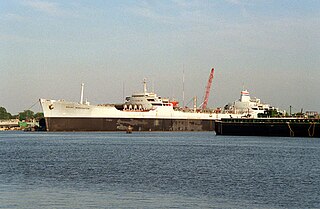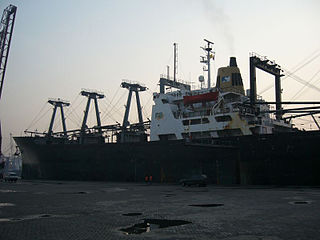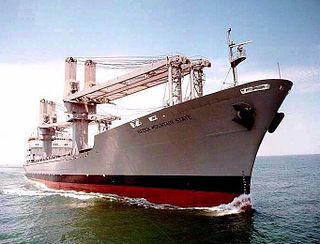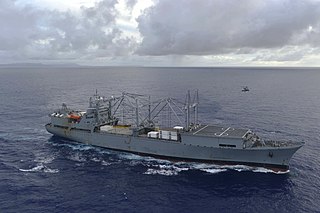
The National Defense Reserve Fleet (NDRF) consists of ships of the United States, mostly merchant vessels, that have been mothballed but can be activated within 20 to 120 days to provide shipping during national military emergencies, or non-military emergencies such as commercial shipping crises.

USS Cyrene (AGP-13) was a motor torpedo boat tender for the United States Navy. She was laid down as Cape Farewell, a Maritime Commission type (C1-A) hull under a Maritime Commission contract, at Pusey and Jones Corp., Wilmington, Delaware. Cyrene served in the Pacific from New Guinea to the Philippines from December 1944 to December 1945. The ship was decommissioned and placed in the Suisun Bay Reserve Fleet in July 1946 then withdrawn from the reserve fleet after sale to American Ship Dismantlers in December 1976.
USTS Empire State VI (T-AP-1001), callsign KKFW, IMO number 5264510, was a troop ship of the United States Navy and training vessel of the United States Maritime Service.

USNS Comet (T-AK-269), later T-LSV-7, later T-AKR-7, later SS Comet, is a vehicle landing ship built for the United States Navy. The lone ship of her class, she is named for the comet, and is the fourth U.S. Naval vessel to bear the name.

USNS Sea Lift (T-LSV-9) was a roll on/roll off (Ro/Ro) cargo ship built for the United States Navy's Military Sea Transportation Service (MSTS), currently the Military Sealift Command (MSC). She became the first ship of Ro/Ro-type to deliver cargo to Vietnam during the war in Indochina.

SS Mount Washington was one of four Offshore Petroleum Discharge System (OPDS) tankers. The Mount Washington was one of the largest of the fleet - 736 feet (224 m) long, a beam of 102 feet (31 m), and a fuel capacity of 364,000 bbl (57,900 m3). Built in 1963 for the commercial trade, the Mount Washington was turned over to the Maritime Administration in 1987 and was placed into the Ready Reserve Force as one thirteen 'Common User Tankers' that can be activated in the event of National Emergency.

SS Wilson was a steam-powered general cargo ship owned by the American company Sealift Incorporated. The ship's keel was laid in 1968, and it was delivered in 1969. Registered under the US flag, its port of registry is Dover, Delaware. The ship was known as Hong Kong Mail until 1978, then President Wilson until 1987, and Sue Lykes until 1995. Its IMO number is 6909911 and its call sign is WNPD. She was classed as a Type C5 class ship, type C5-S-75a. SS Wilson and other C5-S-75a ships were built by Newport News Shipbuilding & Drydock Company at Newport News, Virginia for the American Mail Line of Seattle, Washington. C5-S-75a ships were built as break bulk cargo or Container ship, with 21,600 shp at 15,950 tons and a max speed of 21.0 knots. Theses were the largest general cargo liners at its time in 1969.

SS Grand Canyon State (T-ACS-3) is a crane ship in ready reserve for the United States Navy. The ship was named for the state of Arizona, which is also known as the Grand Canyon State.

SS Keystone State (T-ACS-1) is a crane ship in ready reserve for the United States Navy. The ship was named for the state of Pennsylvania, which is also known as the Keystone State.

SS Gem State (T-ACS-2) is a crane ship in Ready Reserve for the United States Navy. The ship was named for the state of Idaho, which is also known as the Gem State.

SS Equality State (T-ACS-8) was a crane ship of the United States Navy. The ship was named for the state of Wyoming, which is also known as the Equality State. She was scrapped in June 2019.

SS Diamond State (T-ACS-7) is a crane ship in the National Defense Reserve Fleet (NRDF) for the United States Navy. The ship was named for the state of Delaware, which is also known as the "Diamond State". The ship was initially a bulk freighter named SS Japan Mail when launched in 1961 and entered service in 1962 with the American Mail Line. In 1971, the ship was lengthened and renamed SS President Truman. In 1987, the vessel was taken over by MARAD and converted to a crane ship and in 1989, renamed Diamond State.

SS Green Mountain State (T-ACS-9) is a crane ship in ready reserve for the United States Navy. The ship was named for the state of Vermont, which is also known as the Green Mountain State.

USTS Kennedy(T-AK-5059), callsign KVMU, IMO number 6621662, is a former commercial freighter and a current training vessel of the United States Maritime Service.

SS Cape Gibson (AK-5051) was a Cape G Class Break bulk cargo ship of the United States Maritime Administration, last used as a training ship at Texas A&M University at Galveston before being scrapped in 2020.
USNS Marine Fiddler was an Alchiba-class cargo ship that served the United States Merchant Marine during the Korean and Vietnam war. Laid down on 15 December 1944 as a Maritime Commission type C4-S-A3 hull, under Maritime Commission contract, she was built at Sun Shipbuilding and Drydock Company in Chester, Pennsylvania. She was launched on 15 May 1945 and delivered 31 August 1945. Operated by Agwilines Inc, she was laid up in the National Defense Reserve Fleet in Suisun Bay, California on 23 May 1946.

The Type C5 ship is a United States Maritime Administration (MARAD) designation for World War II breakbulk cargo and later a container ship for containerization shipments. The first type C5-class ship was a class of ships constructed and produced in the United States during World War II. The World War II C5-class ship was dry bulk cargo ship built by Bethlehem Steel in Sparrows Point, Maryland. Bethlehem Steel built eight ships in this bulk cargo class and four orders were canceled. The C5-class ship has a 24,250 DWT and was 560 feet (170 m) long. The C5 was mainly used as iron ore carriers. The C5 was needed to replace other ships that sank during World War II. First in her class was SS Venore, USMC #1982, delivered on 20 July 1945. The Type C5-class ship designed to fill the need to move iron ore from Santa Cruz, Chile, to Sparrows Point, Maryland, through the Panama Canal, a round-trip of 8,700 nautical miles . Post World War II, four ships were given C5 class type C5-S-78a, these were roll-on/roll-off container ship built by Ingalls Shipbuilding, Inc. of Pascagoula, Mississippi and operated by the Moore-McCormack Lines. The C5-S-78a had a deadweight tonnage of 16,000 tons.

USNS Furman (T-AK-280) was a Norwalk class Fleet Ballistic Missile Cargo Ship, which was launched as a World War II commercial Victory cargo ship, the SS Furman Victory under the Emergency Shipbuilding program. The Furman Victory was acquired by the U.S. Navy in 1963.

Pacific Reserve Fleet, Alameda was a part of the United States Navy reserve fleets, also called a mothball fleet, that was used to store the many surplus ships after World War II. The Pacific Reserve Fleet, Alameda was part of the former Naval Air Station Alameda in Alameda, California, in the San Francisco Bay. Some ships in the fleet were reactivated for the Korean War and Vietnam War.


















